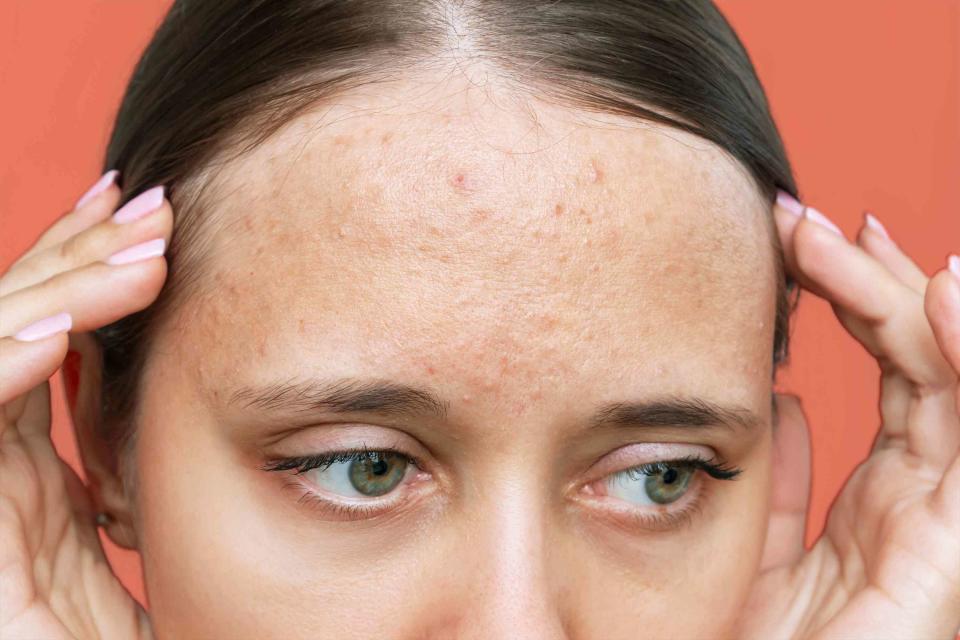What Is Comedonal Acne? We Asked Derms How to Treat This Common Skin Condition
Read this before you pop.

Marina Demeshko/Getty Images
Skin issues aren’t fun for anyone. And for many, the quest for a clear, radiant complexion is a lifelong journey. One of the best ways to improve the condition and texture of your skin’s surface is to understand what type of breakouts you’re experiencing so you can better treat them. After all, hormonal acne looks different than comedonal acne. Haven’t heard of the latter? You probably have—but by a different name: whiteheads and blackheads.
We spoke with dermatologists to identify comedonal acne, its causes, and the best ways to treat it.
What is comedonal acne?
Fun fact: Dermatologists distinguish between acne types, including papules (bumps), pustules (pus-filled bumps), and comedones. Comedones are specifically the pores that have been clogged due to sweat, dirt, dead skin cells, and bacteria, explains Papri Sarkar, M.D., a board-certified dermatologist in Newton, Mass. Those whiteheads and blackheads you’ve experienced along your nose or forehead are a type of comedone, and the color depends on what the pore has experienced. Basically, blackheads are "open" while whiteheads are "closed."
“If a comedone is open to the air, the surface of it looks black due to oxidation from the surrounding air. If a comedone is white, it is enclosed in the skin, so the interior of the comedone looks white,” explains Dr. Sarkar. They can happen anywhere on the body, but the most common areas are the face, neck, ears, and back regions.
How common is comedonal acne?
If you’ve experienced comedonal acne, you’re definitely not alone. In fact, the vast majority of people will have this breakout type at some point in their life. However, it is more prevalent in the teenage years because the puberty hormones stimulate the sebaceous glands to secrete sebum, according to Emily Porter Gerson, M.D., board-certified dermatologist and the co-owner of Gerson Zatezalo Skin + Face in Washington, D.C.
However, because numerous other factors cause comedonal formation, Dr. Gerson reports she has diagnosed patients of all ages. For example, she says the excessive use of thick moisturizers, a smoking habit, living in a high humidity climate, and the consumption of high-glycemic-index foods can all cause comedonal acne.
How can you identify comedonal acne?
As Dr. Sarkar explained, blackheads will look darker in color, and they will be slightly raised. Whiteheads are on the smaller side and will appear as the same shade of your skin. When you run your fingers over this breakout, Dr. Gerson says it will feel like a tiny, firm group of bumps. “While it is a bad idea to squeeze comedones, as that can trigger an inflammatory reaction when a closed comedone is squeezed, no material will be expressed from it,” she explains.
Most often, closed comedones (whiteheads) are typically gathered on your face or body, but open comedones (blackheads) tend to collect in areas of your skins where you have more pores and oil production, like the nose, cheeks, chin, and in between your brows, says Anna Guanche, M.D., board-certified dermatologist and founder of Bella Skin Institute in Los Angeles.
How to Treat Comedonal Acne
The first plan of action is typically using a topical treatment. Dr. Sarkar says there are many available creams, cleansers, and exfoliants that tackle and alleviate comedonal acne symptoms. Look out for these ingredients specifically:
Benzoyl peroxide: Dr. Sarkar says this is one of the most effective treatments since it penetrates deep within the skin, kills bacteria, lessens inflammation, and then works as an exfoliant. “Benzoyl peroxide can be irritating though, so start slow and work your way up in terms of frequency,” she warns.
Salicylic acid: This is a type of beta-hydroxy acid that helps treat comedones. Dr. Sarkar says it works by gently breaking the bonds that hold skin cells together so they can loosen and slough off.
Vitamin A derivatives: These include retinoids and retinols, which work to exfoliate and speed up the cell turnover, so you get a clearer surface. “The new skin appears, and over time the old skin sloughs off. And, you can see less formation of new comedones and resolution of the old one,” she explains.
Tried all of the above? You should always speak with your dermatologist if you’re concerned about ongoing comedonal acne. They can recommend a personalized treatment plan for you. For example, Dr. Gerson says your dermatologist can work with you to take a systemic option for treating comedonal acne for severe cases. This includes hormonal therapy, such as birth control pills or Spironolactone, as well as isotretinoin, which is often referred to as Accutane. “Hormonal therapy takes months of consistent use before seeing improvement, whereas results are much more immediate and long-lasting with isotretinoin,” she notes. With either, though, it’s essential to understand the risk factors and ensure you are ready to commit to the treatment plan.
For more Real Simple news, make sure to sign up for our newsletter!
Read the original article on Real Simple.

